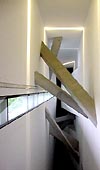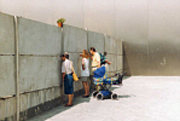
 Classical Music Classical Music
 Cultural Institutions Cultural Institutions
 Galleries Galleries
 Museums+Collections Museums+Collections
 Ancient History Ancient History
 Art & Design Art & Design
 German History German History
 Other Other
 Opera Opera

|
Jewish Museum Berlin
www.jmberlin.deinfo@jmberlin.de
Lindenstrasse 9-14, 10969 Berlin - Kreuzberg | Tel: 25 99 33, Fax: no fax | U: Kochstrasse, U/S: Hallesches Tor | Times: daily 10-18 | Price: free. | In preparation for the museum´s first exhibit in September 2001, the guided tour program has been interrupted and only individual sections of the building remain open for visitors. A short film about the founding of the museum runs on permanent loop in the basement. From September 12th the new permanent exhibition will be open to the general public. The first week will be marked with daily festivities with the first weekend especially suitable for families.
map:
 The Jewish Museum is one of the most striking pieces of architecture in modern Berlin, no small feat considering the city's recent building boom. The silver lightning bolt cutting through residential Kreuzberg is the result of an international competition which challenged architects to design a building that would house a permanent exhibition chronicling German-Jewish history. The winning design was by Daniel Libeskind, a Polish-born Jew whose important theoretical contributions to architecture had never been put to the practical test. His building is full of sloping walkways, black-walled voids and irregular windows designed to throw the visitor off balance. The architecture reflects the many creative contributions made by Jews to German culture and learning over the centuries when Berlin was home to one of the most vibrant Jewish communities in Europe. The void left by the holocaust is represented by a vast, empty, echoing tower, and the disorientation of immigration to a new land by the E. T. A. Hoffmann garden. See the museum website for more information and images. The Jewish Museum is one of the most striking pieces of architecture in modern Berlin, no small feat considering the city's recent building boom. The silver lightning bolt cutting through residential Kreuzberg is the result of an international competition which challenged architects to design a building that would house a permanent exhibition chronicling German-Jewish history. The winning design was by Daniel Libeskind, a Polish-born Jew whose important theoretical contributions to architecture had never been put to the practical test. His building is full of sloping walkways, black-walled voids and irregular windows designed to throw the visitor off balance. The architecture reflects the many creative contributions made by Jews to German culture and learning over the centuries when Berlin was home to one of the most vibrant Jewish communities in Europe. The void left by the holocaust is represented by a vast, empty, echoing tower, and the disorientation of immigration to a new land by the E. T. A. Hoffmann garden. See the museum website for more information and images.
|
House at Checkpoint Charlie
(Haus am Checkpoint Charlie)
Haus am Checkpoint Charlie 44, 10969 Berlin - Kreuzberg | Tel: 25 37 25-0 , Fax: no fax | U6 Kochstr | Price: DM8, Cons. DM5 | Times: 9:00-22:00
map:
Checkpoint Charlie is a remarkable location for a museum about the former GDR. Unfortunately the privately-owned Haus am Checkpoint Charlie glorifies the victory of capitalism over communism with maudlin art, melodramatic descriptions of escapes over the Wall, and long-winded digressions about peaceful resistance to tyranny in Eastern Europe. The fall of the Wall was indeed an international symbol of the end of the cold war, and of freedom in a united Europe, but the museum neglects to explore the complications of dichotomies like those the wall represented. It substitutes romantic stories for difficult explorations of East German reality. The descriptions are translated into English, French and Russian. Too bad the display contains an exhausting amount of text.
|
House of the Wansee Conference (Gedänkstätte Haus der Wansee-Konferenz)
www.ghwk.deinfo@ghwk.de
Am Großen Wansee 56-58, 14109 Berlin - Wansee | Tel: 80 50 010, Fax: 80 50 01 27 | S-Bahn Wansee + Bus 114 | Price: Free | Times: Daily 10:00 - 18:00
map:
In January 1942, SS General Heydrich called together a meeting of top public servants to discuss the implementation of the "final solution to the European Jewish question." The lakeside villa at which the meeting at which the conference was held is now a memorial museum. Minutes of the meeting, taken by Adolf Eichmann, form the centerpiece of the permanent exhibition which documents the conference and provides basic information on the entire process of the segregation, persecution and genocide of European Jewry.
|
German Historical Museum
(Deutsches Historisches Museum)
www.dhm.de/allgemein.htmlwebadmin@dmh.de
Unter den Linden 2, 10117 Berlin - Mitte | Tel: 20 30 40 , Fax: 20 30 4-509 | S-Bahn Hackescher Markt, Bus 100 | Free entry | Times: Daily except Wed 10:00 - 18:00, Thu 10:00 - 22:00.
map:
The permanent home of the German Historical Museum (DHM) in the Zeughaus (address above) is being renovated and will be closed until 2002. In the mean time the DHM has a temporary home accross the road in the Kronprinzenpalais (Unter den Linden 3). The main collection of the museum is not open to the public during the renovations. The DHM in the Kronprinzenpalais shows a programme of topical exhibitions.
|
German Resistance Memorial Center
(Gedenkstätte deutscher Widerstand)
www.gdw-berlin.de/indexe.htmlinfo@gdw-berlin.de
Stauffenbergstr. 13-14, 10785 Berlin - Tiergarten | Tel: 26 99 50 00, Fax: 26 99 50 10 | S-Bahn Potsdamer Platz; | Times: Mon, Wed, Fri, 9.00-18.00;Thu 9.00-20.00; Public Holidays 10.00-18.00 | Price: Free
map:
On the grand scale of things there wasn't much resistance to the the Nazi dictatorship of 1933-45; sources of potential dissent where located early and shut down. Those brave souls who did resist are the subject of this permanent exhibition in rooms which were part of German army headquarters during WWII. The museum is located here because it was from this building that Claus Schenk Graf von Stauffenberg planned his botched attempt on Hitler's life in 20. July 1944. Guided tours of the exhibition are free and are well worth while as they cover the rise and fall of Nazi Germany as well as those who resisted it.
|
Memorial of German Separation (Gedenkstätte Berliner Mauer)
Bernauer Str , 13355 Berlin - Wedding | Tel: 464 10 30, Fax: 464 4755 | U8 Bernauer Straße | Price: Free. | Times: (Documentation Centre) Wed-Sun 10-17. | Tours can be arranged by faxing the centre beforehand. | Photo © Heiko Burkhardt.
map:
 After the fall of the wall the authorities acquired this section as a memorial to those who suffered under communism. Complete with border defences and "death strip", it is carefully protected from tourist hammers and local grafitti artists and is probably one of the best places to view the wall as it used to be. Across the road at Bernauer Str. 111 is the Berlin Wall Documentation Centre (Dokumentationszentrum Berliner Mauer), which has extensive displays and information about the history of the wall. The neighbouring Church of Reconciliation (Kapelle der Versöhnung) is built in no-man's land on the site of a church destroyed during the building of the wall and acts as a memorial to all those who died trying to escape the communist regime. After the fall of the wall the authorities acquired this section as a memorial to those who suffered under communism. Complete with border defences and "death strip", it is carefully protected from tourist hammers and local grafitti artists and is probably one of the best places to view the wall as it used to be. Across the road at Bernauer Str. 111 is the Berlin Wall Documentation Centre (Dokumentationszentrum Berliner Mauer), which has extensive displays and information about the history of the wall. The neighbouring Church of Reconciliation (Kapelle der Versöhnung) is built in no-man's land on the site of a church destroyed during the building of the wall and acts as a memorial to all those who died trying to escape the communist regime.
|
Topography of Terror
(Topographie des Terrors)
www.topographie.de/e/index.htminfo@topographie.de
Niederkirchnerstr 8, 10963 Berlin - Kreuzberg | Tel: 25 48 67 03, Fax: 262 71 56 | S-Bahn Anhalter Bahnhof | Price: Free | Times: Daily. Oct-April 10:00-18:00 (or until dark); May-Sept 10:00-20:00
map:
This outdoor exhibit borders former Prince Albrecht Strasse (now Niederkirchnerstrasse), the street that was the center of Nazi bureaucratic power during the Third Reich. Most official buildings in the area were destroyed during wartime bombings, which inexplicably left the Martin Gropius Building at the exhibit's entrance unharmed. In the distance looms a decrepit looking arch, what's left of the former Anhalter station. Through pictures and texts, the exhibit explores the history of the Gestapo, the SS, and the Reich's state security. Although translations of some information are available, the English version skimps on the story, and the German texts are long and complex. The area exhumes a feeling of historical mystery, but if your German´s not great it's probably worth investing in the English language catalogue for DM2. English commentary is also available on headsets. Plans to incorporate a library and an archive into the exhibition centre are on hold due to lack of funding. A further point of interest; the wall which separates the site of the exhibition from Niederkirchnerstr. is a protected remnant of the original Berlin Wall.
|

 top of page top of page
 ©
1999-2011 Berlin Information Group ©
1999-2011 Berlin Information Group anything missing or wrong? anything missing or wrong?
|

|

